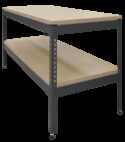Experiment
TD1001

IDEAL GASES - GAY-LUSSAC'S LAW
Bench top apparatus that demonstrates the relationship between pressure and temperature of a fixed volume of ideal gas.
If you have any questions or you'd like to discuss a product, please call us.
+44 1159 722 611IDEAL GASES - GAY-LUSSAC'S LAW
The bench-mounting equipment includes a back plate that holds a low-pressure vessel. The vessel holds a fixed volume of air surrounded by an insulated heater, controlled by an electronic temperature controller. A hand-operated valve at the bottom of the vessel allows students to normalize the air in the vessel to ambient conditions.
The equipment uses normal clean dry air, as it behaves as an ideal gas over the range of pressures used in this equipment.
A thermocouple measures the temperature of the heater surface for the controller. Two thermocouples measure the temperature of the air in the vessel. A pressure transducer measures the pressure of the heated air in the vessel. A digital display shows the absolute pressure, both temperatures and their average value.
Students set the controller for the range of temperatures needed during the experiment. They then record the changes in pressure as the temperature increases and plot the results to prove Gay-Lussac’s Law.
The experiment can also work in reverse; students heat the vessel, open the valve to normalize the air in the vessel, then shut the valve. They then record the pressure and temperature drop as the vessel cools naturally. This gives a different starting point and results which will fall below local ambient. Due to the slow nature of natural cooling, the optional VDAS® is helpful in this test to log results automatically.
You can do tests with or without a computer connected. However, for quicker tests with easier recording of results, TecQuipment can supply the optional Versatile Data Acquisition System (VDAS®). This gives accurate real-time data capture, monitoring and display, calculation and charting of all the important readings on a computer.
Learning outcomes
- Demonstrates change of pressure of a fixed volume of gas during heating.
- Proving Gay-Lussac’s Law by experiment.
- The principle of a vapour pressure thermometer.








